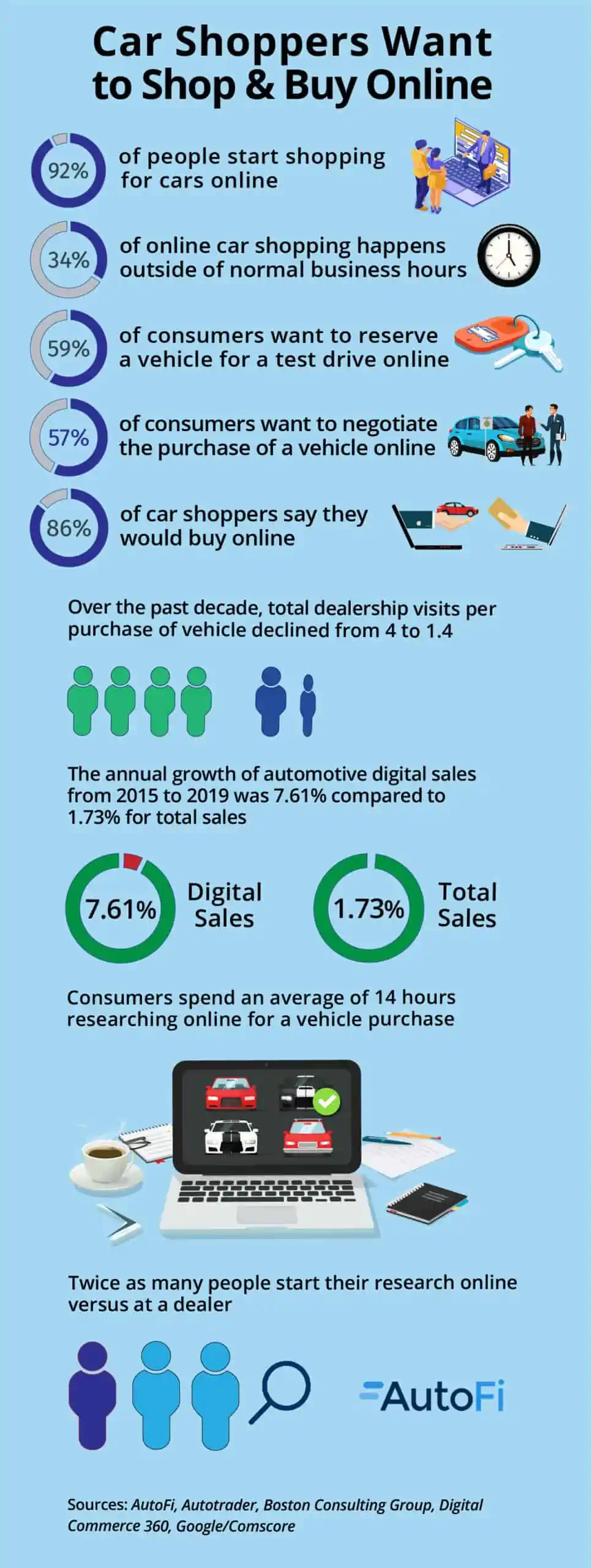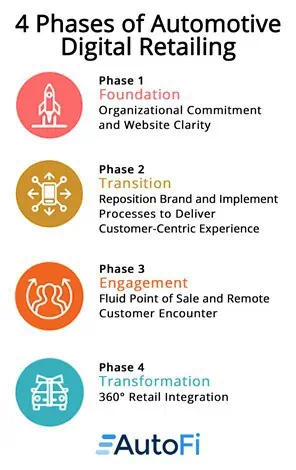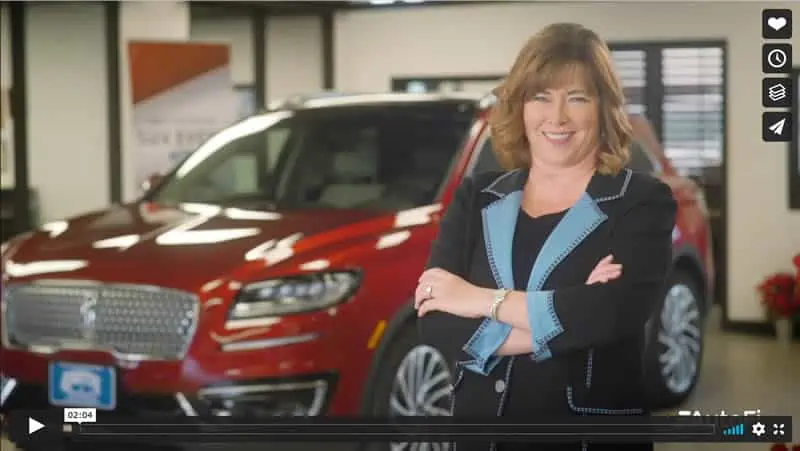People shop for cars online. And, more and more, they actually want to buy cars online. I draw on my 15+ years of experience in the automotive industry to tell you everything you need to know about selling cars online. Plus, secret tips for car dealers that will make digital retailing work best for them and their customers.
In this Article:
- What is automotive digital retailing?
- Feature checklist for automotive digital retailing solutions
- 5 Steps for implementing a digital retailing platform
- The future of automotive digital retailing
What Is Automotive Digital Retailing?
Automotive digital retailing is a process that transforms how car dealers sell vehicles. Dealers use it to merge online tools with their traditional in-person customer service to serve all customers better. These tools allow customers to purchase vehicles entirely online.
For dealers, good automotive digital retailing turns every member of the sales team into a digital retail agent. They provide in-person assistance to all customers. But they also offer seamless help to customers who began shopping on the dealer’s website and who used the dealer’s online tools to move through the purchasing process.
Good automotive digital retailing also means a dealer’s traditional marketing and sales are completely connected and mingled with its online marketing and sales. A dealer’s website is not an extension of its showroom; its showroom is now an extension of its website. Consumers can search for and purchase a car or truck on their own time, how they want.
What Automotive Digital Retailing Isn’t
Automotive digital retailing isn’t simply a website with photos of cars and prices and basic calculators to estimate payments. And it isn’t a website that mainly encourages customers to come to the dealership for more information to buy the vehicle.
Automotive digital retailing instead allows dealers to provide coordinated assistance for all customers. That includes customers who might prefer to shop online and then buy the vehicle in the dealership or those who would rather complete many or all of those steps online.
Elements of Automotive Digital Retailing
Automotive digital retailing systems allow car dealers to present an online “showroom” to potential customers to learn more about cars, costs and buy one online.
Elements of an automotive digital retailing system include:
- An online search function that allows customers to look for specific vehicles and prices
- Detailed online information on finance options and calculators that determine monthly payments based on variables
- Ways to ask the dealership for more information and schedule a test drive
- Financing information and credit applications online and immediate online decisions on credit approvals from a range of lenders
Components of an Automotive Digital Retailing System
An automotive digital retailing system allows customers to find a specific car, get a guaranteed offer on their trade-in, and even decide on a loan.
Here are some things an automotive digital retailing system allows consumers to do:
- Conduct a detailed search for a preferred vehicle based on type, make, model, year, price, and more
- Read information about brands that a manufacturer or car dealer sells
- Configure a car or truck with options
- See transparent and upfront pricing
- Review all information on rebates and other incentive offerings tailored to their needs
- View specifics on taxes and fees
- Get not just an estimate but a guaranteed instant cash offer on a trade-in vehicle
- Explore payment options and configure based on budget
- Consider a range of additional purchase options, including an extended vehicle service contract, “gap” insurance that covers the difference between your car’s worth and what you might owe after an accident or theft, and warranties on wheels and tires
- Find details on financing options from a range of specific lenders
- Complete a credit application online, with strong digital security protections, and get an instant online decision on credit approval and a firm offer of credit, if approved
- Ask for more info
- Request a phone call or meeting with a dealer representative
- Schedule a test drive
- Purchase the car online
- Schedule pickup at dealership or dealer delivery
In addition to all of the above, the system allows dealers to make the process much easier for consumers. The digital retailing solution connects the customer’s online research and activity with the dealer’s representative in the showroom. For example, when the shopper comes to the dealership for a test drive, the dealer already knows who they are, and everything they’ve done to that point, and the car is ready for the test drive.
Benefits of Automotive Digital Retailing for Dealers
Automotive digital retailing can help car dealers improve relationships with customers and enrich their experience. The system increases sales and profits.
Some of the main advantages of automotive digital retailing for dealers:
- Builds transparency and trust with customers, which fosters better customer relationships and more loyalty
- Improves your customers’ experiences with you
- Boosts the connections between your customer and your dealership
- Increases sales
- Makes your dealership more efficient, as its sales per sales rep increases
- Produces a more streamlined workflow for workers
- Increases margins on sales, and your net profit
- Creates seamless deals with fewer errors and hiccups
- Brings about happier and more motivated employees
- Reduces customer friction with financing and insurance components of sales
- Extends dealership reach as people become aware of the online and overall experience
- Transforms how the dealership engages with customers and sells vehicles
Building the Business Case for Automotive Digital Retailing

Here are some of the stats that underline how the car buying process is changing:
- 92 percent of people start shopping for a car online
- 86 percent of car shoppers say they would buy online
- 34 percent of online car shopping happens outside of normal business hours
- The annual growth of automotive digital sales from 2015 to 2019 was 7.61 percent, compared to 1.73 percent for total sales according to a Digital Commerce 360 2019 Ecommerce Report
Learn more about the benefits of digital retailing in auto sales.
Benefits of Automotive Digital Retailing for Consumers
Automotive digital retailing also helps consumers. They can shop when they want, exploring options on their own time. They can get specifics on prices, possible loan payments, and an offer on their trade-in.
Here are some primary automotive digital retailing benefits for customers:
- The “Showroom” Is Always Open: A consumer can shop after work, late at night, or early in the morning—the hours most businesses aren’t open.
- More Control of the Experience: Customers can explore on their own time, at their own pace, setting parameters on vehicle type and price range.
- Better Transparency: Shoppers get upfront information on car prices and available rebates, along with a range of loan options. They can also get a guaranteed instant cash offer on their trade-in vehicle.
- Rebate and Incentive Information: Shoppers can see all rebates and incentives offered on new cars.
- A Comfortable Environment: Customers can shop for and buy a vehicle—and consider any additional options, such as protection plans, they may or may not want—in the low-pressure environment of their home.
- Easy Next Steps: Consumers can decide and reach out if they want to contact a representative for more information or schedule a test drive online.
- Explore Financing Options: Customers can apply online for credit and get an instant decision on credit approval from a range of real lenders on the site.
- Quicker Purchasing Experience: A buyer can complete a purchase in much less time online—often about an hour versus the three hours common in a dealer showroom.
- Entirely Online Buying Option: Many buyers may want to test drive and wrap up details at the dealership. But digital retailing offers customers the option of completing the purchase entirely online, without ever visiting a showroom. The process also allows for all parties to sign contracts online. Once they purchase the car, customers can then schedule a time to pick it up or have it delivered to their home or business.
How to Choose the Right Automotive Retailing Platform for Your Dealership
When choosing an automotive retailing platform, you want to ensure it has all features and components you and your customers will need to complete a vehicle deal.
Here are some primary components and features to look for in a digital retailing platform:
Consumer-Facing Features
- Communicating with the Dealership
- Consumers should be able to schedule a test drive or request more information easily
- The system will save pre-calculated information like trade-in value
- Pricing
- Allows shoppers to explore payments
- Employee pricing for customers with company-related discounts
- Rebates and incentives for new cars
- Private offer
- Instant cash offer
- Trade-in estimated value
- Taxes and fees
- Finance and other purchase options that allow customers to consider and include financing and other alternatives earlier in the purchase process
- Credit
- Includes a credit estimator that helps shoppers select cars within their budgets using a soft-pull credit application
- Provides a credit application on the platform
- Give shoppers an instant decision on approval for their credit application from lenders
- Purchasing/Post-Purchase
- Allows for changing terms post offer
- Counteroffer presentation
- Schedule pickup/delivery
Dealer-Facing Features
- Dealer Portal
- Dashboard
- The dealer should be able to use a customer profile to see what customer explored online
- Remote Purchasing
- Send remote deal options and agreements to a potential buyer
- Handle dealer trades
- Notifications
- Smart customer relationship management (CRM) routing that integrates with the dealer’s CRM system
- CRM customization
Security Features
- Service Organization Control (SOC) 2 Type II Security
A stringent standard that provides a high-level of security in a platform
Automotive Digital Retailing Checklist
Dealers will want to consider some basic features that give customers vital information and control to purchase a car online.
Automotive Digital Retailing Feature Checklist
- Powerful search function with detailed parameters to find a specific car
- A way to easily request more info from dealer/schedule a test drive
- Provide detailed car price, including discounts and any taxes and fees
- Offer an estimated value for customer’s trade-in vehicle
- Ability to consider and purchase special protection options for vehicle
- Creditor estimator so customers can see eligible interest rates
- Credit application that gives customers a choice of lenders and the ability to apply for and get approved credit on your website
- A way to schedule a time to pick up or deliver the vehicle
- Strict online security protections
How to Implement Digital Retailing at Your Dealership
Starting a digital retailing system at your dealership requires more than creating a new website and waiting for customers to arrive. You need to set out key goals and work to reach them.
5 Steps to Implementing Automotive Digital Retailing at Your Dealership
- Create a vision statement for your dealership
Write down your overall goals for incorporating digital retailing into your business. This list should be concise but also specific. Objectives should be inspiring and forward-looking. - Establish your brand promise
Decide what your dealership wants to promise all customers about its goals, values, and how it does business. - Build a purchase-focused website
The site must have more than photos of specific cars with prices and repeated invitations to come to the dealership. Customers need to move forward toward purchasing a car by giving them information on the value of their trade-in, final prices, and financing options. Shoppers also should be able to apply for credit and buy a vehicle entirely online if they choose. - Ensure your digital retailing seamlessly merges with all aspects of your dealership
For example, when a customer comes to your dealership after completing your website’s actions, your representative understands everything that the customer has done online. - Don’t treat online customers as “leads” to convince to come into your dealership
You must understand that digital retailing means you can and should sell vehicles to people entirely, or almost entirely, online. You need to answer all questions directly and be as helpful as possible through the digital retailing platform.
4 Phases of Auto Digital Retailing

Read our article on the phases of digital retailing to learn more.
Automotive Digital Retailing Best Practices
Dealers should consider some key “best practices” as they implement and develop their digital retailing strategy. These practices will ensure they get the most value out of their marketing and advertising efforts.
Proven Practices in Automotive Digital Retailing:
- Build a Clean and Helpful Website: Your site should help customers and allow them to focus on making a possible purchase. Do not include eight or ten various call-to-action (CTA) buttons to get their contact information. You only need one or two buttons for that, and you should label them “shop now” and “learn more,” for example.
- Provide Pricing and Other Important Information Directly and Upfront: In addition to car prices, you need to provide direct information about trade-in values, financing, and other information vital to a customer. Digital retailing isn’t about getting a customer to contact you to get that information; it’s about providing as much information as possible directly through the platform.
- Don’t Use Jargon and Abbreviations: Customers aren’t auto dealers. They don’t know your jargon. Many have no idea what OEM means, for instance. Make sure your grandmother can understand the language on your website.
- Coordinate Your Advertising: Your dealership’s advertising must be consistent with the brand promise established as part of your digital retailing strategy. Use that branding on your platform and in all advertising. Be sure your advertising directs people to your website.
- Use Information from Digital Retailing to Really Prepare for Meeting Customers: A few customers may want to use your digital retailing platform for the entire purchase process. But most will want to come to the dealership for a test drive and to complete the purchase. When they arrive, you shouldn’t greet them as if they just walked in off the street. You should know everything they’ve done on the platform, including all information they’ve provided and requested. You should have insights into what they like and don’t like, how much money they have to spend, and a range of other things. You must use those insights to show that you understand them and their concerns.
- Understand that Digital Retailing Expands Your Points of Sale: Your sales team might believe they can only actually sell a vehicle at the dealership. So their focus is getting customers at a desk in the dealership. Digital retailing means that you now have many points of sale. You can complete most—or sometimes all—phases needed to sell a vehicle through the platform. You have to use the platform correctly.
- Exceed Expectations and Wow Customers: A digital retailing platform allows your dealership and your customers to share a wide range of helpful information. You get to know your customers and their needs before ever meeting them. Customers can move through the phases of shopping for and buying a vehicle on their own time. You must use all of those advantages to understand your customer’s aspirations and make the final purchase as quick and straightforward as possible.
Automotive Digital Retailing Case Studies
Dealers throughout the U.S. and Canada are adopting automotive digital retailing to increase sales and profits. Here are several case studies detailing how dealers have made auto digital retailing work for them.
- The Matt Blatt Dealership has three dealerships in New Jersey. After COVID 19 shut down operations of most businesses in New Jersey in March and April of 2020, the dealership used the AutoFi platform to revise its brand and include a simple CTA on its website. The CTA focused on quick and easy remote sales—without customers needing to come to the dealership.One of their dealerships sold 32 percent more used cars in May 2020, with employees working from home, than in May 2019 with an open showroom. The company now sells 75 percent of its vehicles through AutoFi.
- Ricart Ford in Ohio is selling 60 vehicles per month on average through AutoFi. About 34 percent of customers whose inquires start through AutoFi eventually make a purchase. That’s far above industry averages.

- Smith South Plains Ford-Lincoln in Texas has seen its internet sales increase by 25 percent using AutoFi.

- Sanderson Ford in Arizona sells an average of 23 vehicles per month through AutoFi. About three-quarters of AutoFi customers buy associated financing and insurance products through the platform.
You can learn more about these and other dealers’ experiences with AutoFi.
Future of Automotive Digital Retailing
I believe expanding automotive digital retailing is the future of selling vehicles. That’s not me looking at a crystal ball; that’s understanding how consumers want to shop—and it’s online.
Consumers now expect convenience in how they buy things. They use their phones to order a pizza quickly. They get their favorite restaurant meal delivered with another click of a button. They click a button on Amazon to buy deodorant that will arrive later that day.
Successful companies (like Domino’s and Amazon) understand how important it is to give the customers the convenience they want. Car dealerships must realize that as well. More and more consumers will continue to shop online for cars. Even more of them will expect to be able to move through most of the process—if not all of it—online.
Dealers that embrace this reality will see increased sales and efficiencies. Dealers that don’t will have a difficult time staying in business.
Turbo-Charge Your Car Sales with An Automotive Digital Retailing Platform
AutoFi makes digital retailing easy for the dealers. AutoFi helps your dealership engage better with customers the way they want, giving them the control they want. Customers are happy, and dealerships sell more cars.
Learn more about the future of digital retailing and how AutoFi’s automotive digital retailing platform works.

